The inner suburbs
Fringing the southern and eastern edges of the city centre – and separating it from the more modern areas beyond – is a necklace of low-key suburbs: Garhoud, Oud Metha, Karama and Satwa. South of Deira, workaday Garhoud is home to the Dubai Creek Golf Club, with its famously futuristic clubhouse, and the adjacent yacht club, where you’ll find a string of attractive waterside restaurants alongside the lovely Park Hyatt hotel. Directly over the Creek, Oud Metha is home to the quirky Wafi complex and the lavish Khan Murjan Souk, while north of here the enjoyably downmarket suburbs of Karama and Satwa are both interesting places to get off the tourist trail and see something of local life among the city’s Indian and Filipino expats, with plenty of cheap curry houses and shops selling designer fakes.

Garhoud
Covering the area between the airport and the Creek, the suburb of Garhoud is an interesting mishmash of up- and downmarket attractions. The Deira City Centre mall is the suburb’s main draw, while on the far side of Baniyas Road lies the Dubai Creek Golf Club, an impressive swathe of lush fairways centred on the quirky clubhouse, with its uniquely spiky white roofline echoing the shape of a dhow’s sails and masts. Close by you’ll find the Dubai Creek Yacht Club, occupying a full-size replica of a ship’s bridge, with dozens of beautiful yachts moored alongside and a cluster of good restaurants lining the waterfront. Next door sits the beguiling Park Hyatt hotel, its serene white Moroccan-style buildings, topped with vivid blue-tiled domes, adding a further touch of style to the creekside hereabouts.
Wafi
The wacky Egyptian-themed Wafi complex is a little slice of Vegas in Dubai, dotted with obelisks, pharaonic statues, random hieroglyphs and assorted miniature pyramids. The mall is home to myriad boutiques and restaurants. The Egyptian theme is continued in the opulent Raffles hotel next door, built in the form of a vast pyramid, its summit capped with glass – particularly spectacular when lit up after dark.
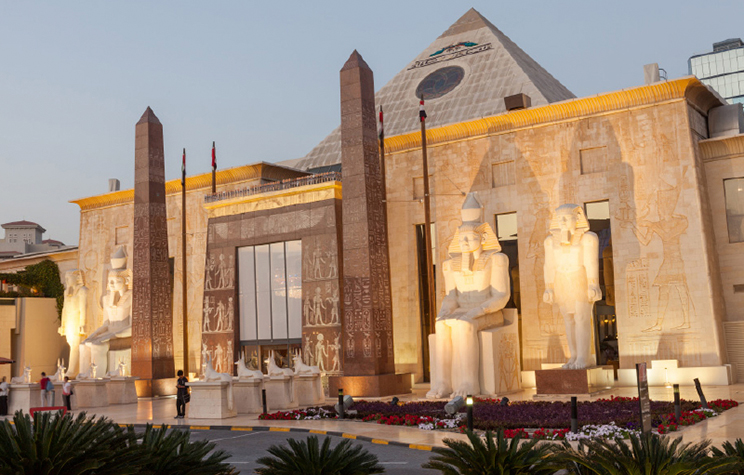
Khan Murjan Souk
Hidden away between Wafi and the Raffles hotel, Khan Murjan Souk is one of Dubai’s finest “traditional” developments, allegedly modelled after the fabled fourteenth-century Khan Murjan Souk in Baghdad. The souk is divided into four sections – Egyptian, Syrian, Moroccan and Turkish (not that you can really tell the difference) – spread over two underground levels, with a lovely outdoor restaurant at its centre and some 125 shops selling all manner of traditional wares. It’s a great (albeit pricey) place to shop, while the faux-Arabian decor is impressively done, with lavish detailing ranging from intricately carved wooden balconies to enormous Moroccan lanterns and colourful tilework.
Creek Park
Flanking the Creek, the expansive Creek Park serves as one of congested central Dubai’s major lungs and is a pleasant place for an idle ramble, with good views over the Creek towards the golf and yacht clubs. The park is nicest towards dusk, when the temperature falls and the place fills up a bit, although it can be eerily deserted during weekdays. It’s particularly good for kids, with plenty of playgrounds and the fun Children’s City to explore, as well as the Dubai Dolphinarium. Children (and, indeed, adults) may also be tempted by the park’s cable car, which offers half-hour trips (25dh; children 15dh) dangling 30m up in the air.
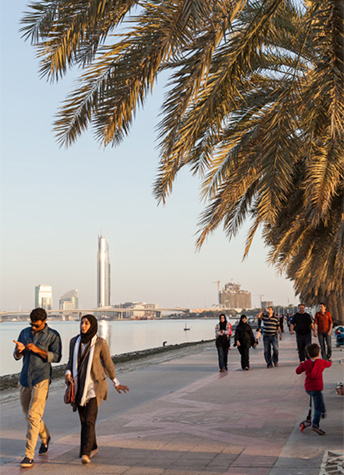
Karama
Karama is the classic Dubai inner-city suburb, home to some of the legions of Indian, Pakistani and Filipino expat workers who supply so much of the city’s labour. The district is centred on Kuwait Street and the bustling little Karama Centre, with colourful shops selling shalwar kameez and Indian-style jewellery. At the end of Kuwait Street lies the lively Karama Park, surrounded by cheap and cheery Indian restaurants. South of here is the district’s main tourist attraction, the Karama Souk, with hundreds of small shops stuffed full of fake designer clothes, watches, glasses, DVDs and other items.
Shopping for fakes
Despite ongoing government clampdowns, Dubai’s vibrant trade in counterfeit goods (bags, watches, sunglasses, pens, DVDs and so on) is still going strong. Spend any amount of time in Karama Souk, the Gold Souk or around Al Fahidi Street in Bur Dubai and you’ll be repeatedly importuned with offers of “cheap copy watches” or “copy bags”, as the souks’ enthusiastic touts euphemistically describe them. Many fakes are still relatively expensive – you’re unlikely to find bigger-ticket items for much under US$50, and plenty of items cost double that, although they’ll still be a lot cheaper than the real thing. Fakes may look convincing but longevity varies considerably; some items can fall to pieces within a fortnight, and it’s essential to check quality carefully – particularly stitching and zips – and be prepared to shop around and bargain like crazy.
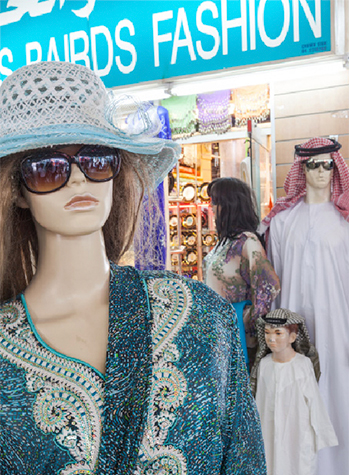
Satwa
The unpretentious district of Satwa is the most southerly of Dubai’s predominantly low-rise, low-income inner suburbs before you reach the giant skyscrapers of Sheikh Zayed Road. It’s also one of the few places in Dubai where the city’s different ethnic groups really rub shoulders, reflected in an unusually eclectic selection of places to eat, from cheap-and-cheerful curry houses to Lebanese shwarma cafés and Western fast-food joints.
At the centre of the district lies Satwa Roundabout. The streets south of here are mainly occupied by Indian and Pakistani shops and cafés, including the well-known Ravi’s. West from the roundabout stretches the tree-lined 2 December Street (formerly Al Diyafah Street), one of the nicest in Dubai – and one of the few outside the city centre with any real street life – with dozens of restaurants, and an interestingly cosmopolitan atmosphere.
Festival City
Festival City is one of Dubai’s newest and largest purpose-built neighbourhoods – a self-contained city within a city, complete with villas and apartments, offices, golf course, marina, shopping mall and a pair of swanky five-star hotels. The centrepiece of the development is the bright, modern Festival Centre shopping mall: relatively small beer compared to other malls around the city, although there are fine, sweeping views from the waterfront promenade outside across the water to the dhow-building yards at Jaddaf and the long line of skyscrapers beyond.
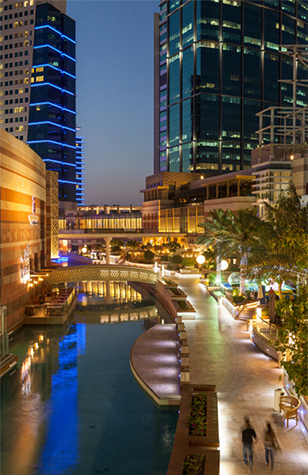
Ras al Khor Wildlife Sanctuary
The Dubai Creek comes to an impressive end at Ras al Khor (“Head of the Creek”), forming an extensive inland lagoon dotted with mangroves and surrounded by intertidal salt and mud flats – a unique area of unspoilt nature close to the city centre. The southern end of the lagoon is home to the low-key Ras al Khor Wildlife Sanctuary, best known for its aquatic birdlife. The sanctuary is an important stopover on winter migratory routes from East Africa to West Asia and almost seventy different species have been spotted here. It’s best known for the colourful flocks of bright pink flamingoes which nest here – one of Dubai’s most surreal sights when seen perched against the smoggy outlines of the city skyscrapers beyond. You can’t actually go into the sanctuary, but you can birdwatch from one of three hides on its edge. Signage for the hides is minimal and you’ll need a car to reach them, but don’t expect taxi drivers to know where they are.
Meydan
The vast Meydan complex provides conclusive proof of the ruling Maktoum family’s passion – bordering on obsession – for all things equine. Founder of Godolphin, one of the world’s most successful racing stables, Sheikh Mohammed’s love of horses runs deep: he is said as a youth to have been able to tame wild horses considered unrideable by others. Centrepiece of the complex is the superb racecourse, opened in 2010 to provide a fitting venue for the Dubai World Cup, the world’s richest horse race with a massive US$10 million in prize money.
Shops
Deira City Centre
This big old mall remains one of the most popular in the city, with 340-plus outlets covering the whole retail spectrum, from cut-price electronics and cheap clothes through to the swanky “Jewellery Court” on Level 1, stuffed full of ultra-bling jewellery and watch shops.
Karama Souk
The best place to find fake designer gear, with dozens of shops stacked full of imitation designer clothing and bags and “genuine fake watches”. There are also a few low-grade souvenir shops dotted around the souk selling kitsch classics like miniature Burj al Arabs moulded in glass.
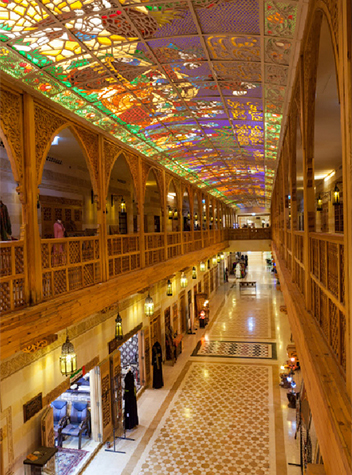
Khan Murjan souk
The hundred-plus stores in this superb replica souk (see Khan Murjan Souk) comprise the city’s best and most upmarket array of traditional crafts shops selling just about every kind of Arabian geegaw, artefact and antique you can think of.
Virgin Megastore
Dubai offshoot of the now defunct UK chain selling a great selection of Arabic pop and other genres from Morocco to Iraq, as well as recordings by many Gulf and Emirati musicians. Other branches at Dubai Mall, Mercato, Mall of the Emirates and The Walk at Jumeirah Beach Residence.
Wafi
This zany Egyptian-themed mall makes for a pleasantly superior shopping experience, with a particularly good choice of independent ladies’ fashion. Outlets include Ginger & Lace (funky ladieswear from international designers), the over-the-top Valleydez and the more understated By Malene Berger, showcasing work by the leading Danish designer.
Wafi Gourmet
The ultimate Dubai deli, piled high with tempting Middle Eastern items, including big buckets of olives, nuts, spices and dried fruits, and trays of date rolls, baklava and fine chocolates.
Café
Al Mallah
A classic slice of Satwa nightlife, this no-frills Lebanese café churns out good shwarmas, grills and other Middle Eastern food at bargain prices (mezze around 10dh, mains around 30dh) to a lively local crowd; the pavement terrace is a great place to people-watch.
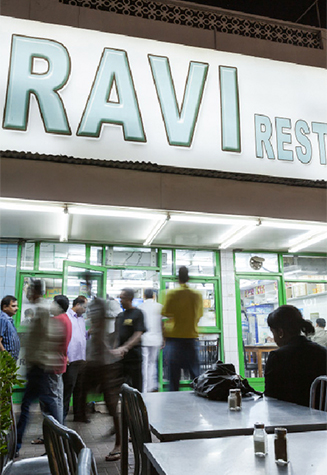
Ravi’s
This famous little Pakistani café, located between the copycat Ravi Palace and Rawi Palace restaurants, attracts a loyal local and expat clientele thanks to its tasty and inexpensive array of subcontinental standards (mains 15–20dh). The interior is usually packed, and it’s more fun (despite the traffic) to sit out on the pavement and watch the street life of Satwa drift by.
Restaurants
Asha’s
Named after legendary Bollywood chanteuse Asha Bhosle, with sleek modern orange decor and an interesting menu featuring traditional North Indian classics alongside recipes from Bhosle’s own family cookbook. Mains 70–95dh.
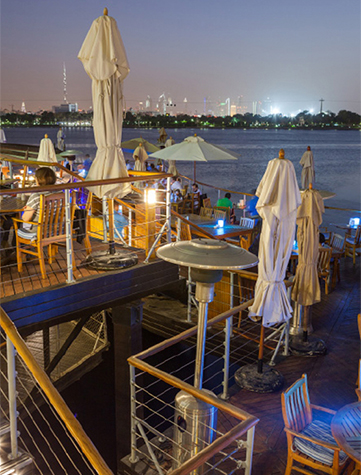
Boardwalk
Unpretentious, always busy restaurant on the yacht club’s creekside boardwalk, with stunning city views and an eclectic range of international meat and seafood dishes (mains 60–90dh), plus a good wine list.
Khan Murjan Restaurant
The centrepiece of the spectacular Souk Khan Murjan, this beautiful courtyard restaurant has proved a big hit with the city’s Emiratis and expat Arabs, thanks to the traditional atmosphere and unusually wide-ranging menu, featuring tempting selections from assorted Middle Eastern cuisines. Mains from around 70dh.
Medzo
Suave little restaurant with a cosy old-school European-style dining room and a good selection of Italian-cum-Mediterranean cuisine – pastas, pizzas and risottos (65–75dh) alongside bigger meat and seafood mains (from 100dh).
QD’s
Fun and good-value restaurant-cum-bar-cum-shisha café in a superb location on a large open-air terrace overlooking the Creek. The cheap and cheerful pub-grub-style menu features lots of pizzas and Lebanese kebabs (mains from around 50dh), and there’s also a big selection of shisha and a well-stocked bar.
Reflets par Pierre Gagnaire
One of the city’s top European fine-dining experiences, showcasing French chef Pierre Gagnaire’s innovative modern French cuisine. The short menu features a mix of regularly changing meat and seafood creations – anything from blue Atlantic lobster to wild pigeon – backed up by heaps of luscious little amuses-bouches. The service is super-smooth, and there’s a spectacular wine list, too. It’s seriously expensive, though – expect to pay around 2000dh/person.
Thai Kitchen
Occupying part of the Park Hyatt’s lovely creekside terrace, this superb restaurant offers all the usual Thai classics alongside a few more unusual regional specialities. Food is served in small, tapas-sized portions (35–55dh), meaning that you can sample a wide range of dishes and flavours.
Bars
Belgian Beer Café
Convivial Belgian-style pub-cum-restaurant, with an eye-catching traditional wooden interior, an excellent range of speciality beers on tap or by the bottle (including draught Hoegaarden, Leffe and Belle-Vue Kriek) and good traditional Flemish cooking.
The Terrace
Seductive (if pricey) waterside bar, with seating either indoors or out on the terrace over-looking the Creek. The mellow and romantic mood is helped along by smooth chill-out music and a nice selection of cocktails and other tipples.